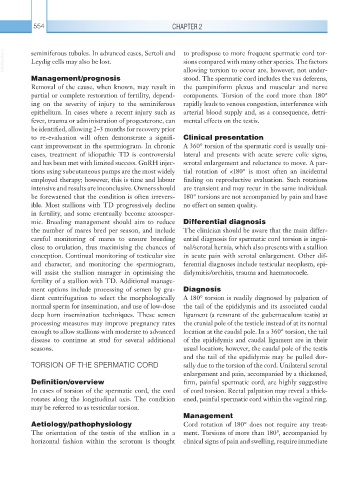Page 579 - Equine Clinical Medicine, Surgery and Reproduction, 2nd Edition
P. 579
554 CHAPTER 2
VetBooks.ir seminiferous tubules. In advanced cases, Sertoli and to predispose to more frequent spermatic cord tor-
sions compared with many other species. The factors
Leydig cells may also be lost.
Management/prognosis allowing torsion to occur are, however, not under-
stood. The spermatic cord includes the vas deferens,
Removal of the cause, when known, may result in the pampiniform plexus and muscular and nerve
partial or complete restoration of fertility, depend- components. Torsion of the cord more than 180°
ing on the severity of injury to the seminiferous rapidly leads to venous congestion, interference with
epithelium. In cases where a recent injury such as arterial blood supply and, as a consequence, detri-
fever, trauma or administration of progesterone, can mental effects on the testis.
be identified, allowing 2–3 months for recovery prior
to re-evaluation will often demonstrate a signifi- Clinical presentation
cant improvement in the spermiogram. In chronic A 360° torsion of the spermatic cord is usually uni-
cases, treatment of idiopathic TD is controversial lateral and presents with acute severe colic signs,
and has been met with limited success. GnRH injec- scrotal enlargement and reluctance to move. A par-
tions using subcutaneous pumps are the most widely tial rotation of <180° is most often an incidental
employed therapy; however, this is time and labour finding on reproductive evaluation. Such rotations
intensive and results are inconclusive. Owners should are transient and may recur in the same individual.
be forewarned that the condition is often irrevers- 180° torsions are not accompanied by pain and have
ible. Most stallions with TD progressively decline no effect on semen quality.
in fertility, and some eventually become azoosper-
mic. Breeding management should aim to reduce Differential diagnosis
the number of mares bred per season, and include The clinician should be aware that the main differ-
careful monitoring of mares to ensure breeding ential diagnosis for spermatic cord torsion is ingui-
close to ovulation, thus maximising the chances of nal/scrotal hernia, which also presents with a stallion
conception. Continual monitoring of testicular size in acute pain with scrotal enlargement. Other dif-
and character, and monitoring the spermiogram, ferential diagnoses include testicular neoplasm, epi-
will assist the stallion manager in optimising the didymitis/orchitis, trauma and haematocoele.
fertility of a stallion with TD. Additional manage-
ment options include processing of semen by gra- Diagnosis
dient centrifugation to select the morphologically A 180° torsion is readily diagnosed by palpation of
normal sperm for insemination, and use of low-dose the tail of the epididymis and its associated caudal
deep horn insemination techniques. These semen ligament (a remnant of the gubernaculum testis) at
processing measures may improve pregnancy rates the cranial pole of the testicle instead of at its normal
enough to allow stallions with moderate to advanced location at the caudal pole. In a 360° torsion, the tail
disease to continue at stud for several additional of the epididymis and caudal ligament are in their
seasons. usual location; however, the caudal pole of the testis
and the tail of the epididymis may be pulled dor-
TORSION OF THE SPERMATIC CORD sally due to the torsion of the cord. Unilateral scrotal
enlargement and pain, accompanied by a thickened,
Definition/overview firm, painful spermatic cord, are highly suggestive
In cases of torsion of the spermatic cord, the cord of cord torsion. Rectal palpation may reveal a thick-
rotates along the longitudinal axis. The condition ened, painful spermatic cord within the vaginal ring.
may be referred to as testicular torsion.
Management
Aetiology/pathophysiology Cord rotation of 180° does not require any treat-
The orientation of the testis of the stallion in a ment. Torsions of more than 180°, accompanied by
horizontal fashion within the scrotum is thought clinical signs of pain and swelling, require immediate

